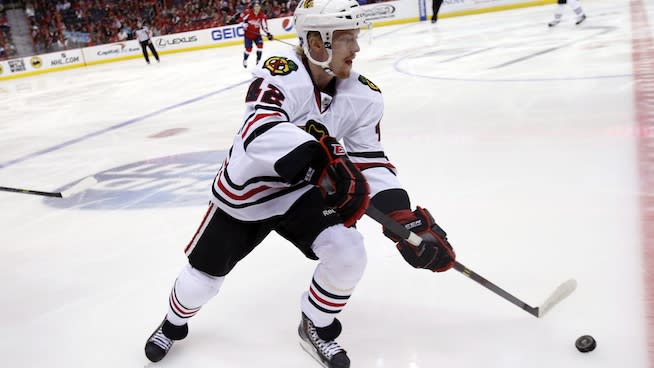Hockey Players: Develop Strong Hips for a Powerful Skating Stride

Hockey players spend most of their time standing on forward-angled skates with their torsos upright and their hips flexed, a position that usually leads to large quads, inactive glutes and tight hip flexors.
Unfortunately, living in this position further tightens the hip flexors and removes the glutes—the largest and most powerful muscle group in your body—from the skating stride.

The body always take the path of least resistance, so the active hip flexors usually take over for weak and inactive glutes. Your hip flexors help you push off the ice and pull your knee up toward your chest in preparation for your next stride. Although they were not intended to contribute to backside mechanics, the hip flexors now do so at the expense of your spine.
WATCH: Henrik Zetterberg's Complete Workout
In reality, the glutes should be the first muscles that fire when you push off the ice, followed by the adductors (which rotate the leg outward), the quadriceps (which straighten the knee) and the hamstrings (which extend the hip).

To see if your muscles are firing in the proper order, take the test shown in the following video.
To develop proper movement patterns and muscle strength needed for a powerful stride, I recommend the following movements. Bonus: Correcting faulty movement patterns and improving mobility help prevent groin strains—one of the most common injuries in hockey.
RELATED: Training With Mike Green and Jordan Eberle
Develop Hip Strength and Stability
Hockey requires you to push off one leg at a time, so you need to train that way. Standing on one leg while maintaining the same body position as if you were on two legs is tough, but it increases core and hip stability, allowing you to contain the energy produced by your legs to produce a stable torso and efficient stride. Try these exercises:
Crawling
Crawling mimics the movement pattern of skating, while training the core to remain completely motionless. It reinforces stride mechanics, and you get a killer core workout. Not bad for a "baby move."
Forward Crawl
Backward Crawl
Chain Crawl
Once you master the bodyweight versions, you can load it with chains.
Single-Leg Squats
When you stand on one leg, the muscles attached to your hip work overtime to keep you stable, improving your core and hip support. Try to sit back and down into your heel, then drive your hips up and forward as you stand back up.
Skater Squats
This exercise takes its name from the mid-point of the movement. It simulates the forward-leg position of a stride, improving stability and stride recovery.
Eccentric Leg Curls
Strong hamstrings reduce the risk of groin pulls, because they reinforce co-contraction of the hamstrings and glutes. To do Leg Curls properly, fully contract your glutes to raise your hips as your hamstrings bend your legs at the knee.
Single-Leg, Straight-Leg Deadlift
The slightly bent knee position of the Single-Leg Straight-Leg Deadlift mimics the position that the leg and hip assume during the contact phase of skating. You promote proper muscle recruitment and a faster, more efficient stride.
Increase Power and Refine Backside Drive Mechanics
Once you develop fundamental strength, you need to convert it to usable power. To do this, it's critical to perform exercises that reinforce driving mechanics and teach your body to put max power into the ice with each stride.
RELATED: Master Stickhandling Fundamentals
High Knee Skip, Forward and Backward
Skipping reinforces the high-knee drive, arm swing and stable core needed to skate.
Partner Chase Sprint
Once you master skipping, progress to sprinting drills such as the Partner Chase Sprint. These increase hip separation and teach you to put force into the ground. Lean as far forward as you can and make a "first push" to start off your sprint rather than a "first step" by rocking back and repositioning your foot (stepping) with your trailing leg.
Sled Pushing and Pulling
The sled is one of the best tools to teach the full extension required in skating as well as sprinting patterns. It also trains the core to remain stable.
This article originally appeared on STACK.com: Hockey Players: Develop Strong Hips for a Powerful Skating Stride


